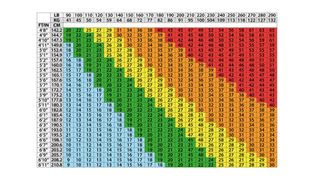How much should I weigh? How to figure out your ideal weight
Wondering how much should I weigh? Don’t be alarmed if your ideal weight and BMI sometimes differ


If you're wondering 'how much should I weigh?' then don't worry, you're not the only one. Healthy body weight is individualized, based on a whole host of factors including height, age, and muscle mass, it can be difficult to get accurate insights from the weighing scales.
The NHS and the World Health Organisation (WHO) still today use a guide called the body mass index (BMI) to determine whether someone is sitting at a healthy weight or not. While medical professionals have often gone against the guide, suggesting that it's inadequate and often inaccurate, there is an argument for its use.
While not everyone looks into their body weight for weight loss purposes, many people do so because they want to get into a calorie deficit to lose weight or learn how to lose weight in a week. If that's you, this is what a nutritionist and fitness trainer wants you to know about how much you should weigh.
How much should I weigh?
Unfortunately, there's no one weight or size that everyone should be because everyone's body is different. So, your ideal body weight is the weight that allows you to be physically and mentally healthy, and it should make you feel strong, stable, and confident.
How much you should weigh entirely depends on individualized factors, many of which are outside your control, including:
- Genetics
- Race or ethnicity
- Age
- Gender
- Eating and exercise habits
- Sleep schedule
"Everyone's body and health journey is different," explains Signe Svanfeldt, nutritionist at Lifesum, the leading nutrition app. So if you are concerned about your weight, the best thing to do is visit a doctor. If you are overweight, may put you on a new diet and exercise plan, which could include workouts like walking for weight loss and a calorie-controlled diet.

There are some signifiers of whether you are sitting in a healthy weight range though. The amount of body fat you have is one of them. Studies by AUT University suggest that women between the ages of 21 to 39 should have between 21% body fat and 32%, while men of the same age should have between eight and 20%.
Sign up for the woman&home newsletter
Sign up to our free daily email for the latest royal and entertainment news, interesting opinion, expert advice on styling and beauty trends, and no-nonsense guides to the health and wellness questions you want answered.
A further study from The Jan Kochanowski University in Poland found that women between 45 and 64 should have no more than 37.1% body fat, whereas men of the same age shouldn't surpass 25.8%. Percentages higher than this, the research found, were proven to have a direct link with higher rates of high blood pressure and type 2 diabetes.
Putting this aside, there is one metric that may offer a relatively accurate idea of what your body weight should be. "BMI can serve as a single starting point to help us begin to develop individualized guidance," she says. "It's an easy and resource-efficient method to use that doesn't require a lot of advanced, expensive tools." All you really need is one of the best body fat scales to weigh yourself on.
There is also research by the University of Bristol to suggest that BMI may be helpful in some cases as a measure of health. "BMI is often criticized," says Dr Joshua Bell, an epidemiologist and study leader. "Our study asked how useful it really is for detecting the health effects of obesity by pitching it against more objective body scan measures. We found that trunk fat is the most damaging to health, but that simple BMI gives very similar answers to more detailed measures. This is good news since BMI is widely measured and costs virtually nothing."
So how can you work out your own BMI? Plus, other measures of weight explained.
What should my BMI be?
BMI is calculated by dividing your weight (or ‘mass’) in kilograms by your height in meters, squared – i.e. BMI = mass in kg ÷ (height in meters x height in meters).
You can also find a BMI calculator on the NHS website. Current guidelines state that a BMI between 18.5 and 24.9 is considered healthy. Those with a BMI of 18 or under are considered underweight, whilst those with a BMI over 25 are classed as overweight.
It's important to note, however, that BMI as an ideal weight guide is an extremely flawed system. "BMI is only a measurement for one's total weight in correlation to one's height," explains Svanfeldt. "It does not take any other aspects into accounts such as body composition, health history, genetics or other kinds of health status."
Particularly in adults, the issue of muscle mass versus fat mass is a big one when it comes to BMI. As research by the University of California outlines, muscle is significantly more dense than fat. "A person could be muscular with very low body fat levels and be in fantastic shape but because muscle is heavy, BMI would class them as obese," says fitness trainer Julia Buckley. "For example, many athletes like rugby players or boxers would be classed as clinically obese if you only looked at their BMI."

You can check how much you should weigh using this handy BMI chart.
Calculate your ideal body weight using the Hamwi Method
While no formula is perfect, the Hamwi Method is another metric you can use that does take body frame size into account, which may enhance accuracy.
Dr G.J. Hamwi, who invented the metric, states that the ideal weight for a woman who is 5ft tall is 100lbs (i.e. 7st 2lbs, or approx. 45kg). Add 5lbs (approx. 2.2kg) for every inch of height over 5ft. For example, a woman who is 5’4 would add 20lbs, making her ideal weight 120lbs, or 8st 8lbs (approx. 54.5kg). For a man, start at 106lbs, adding 6lbs for every inch over 5ft.
Women with a small frame should subtract 10% from this result. If you have a large frame, you should add 10%. So, after adjustment, the ideal body weight for a small-framed woman of 5’4 becomes 108lbs (7st 7lbs, or approx. 49kg). This weight would place her on the borderline between healthy and underweight according to her BMI calculation (18.5). The ideal body weight for a large-framed woman becomes 132lbs (9st 6lbs, or approx. 60kg). This weight would place her towards the upper end of the ‘healthy’ BMI range, with a result of 22.7.
How to calculate frame size
Measuring your wrist circumference with a tape measure is a simple and fairly reliable proxy for calculating frame size.
Women under 5’2
Small: wrist circumference less than 5.5″ Medium: wrist circumference between 5.5″ and 5.75″ Large: wrist circumference over 5.75″
Women between 5’2 and 5’5
Small: wrist circumference less than 6″ Medium: wrist circumference between 6″ and 6.25″ Large: wrist circumference over 6.25″
Women over 5’5
Small: wrist circumference under 6.25″ Medium: wrist circumference between 6.25″ and 6.5″ Large: wrist circumference over 6.5″
Men over 5’5
Small: wrist circumference under 6.5″ Medium: wrist circumference between 6.5″ and 7.5″ Large: wrist circumference over 7.5″
Next time you step on the scales and try to work out your BMI, don’t blanch in horror at the results. “I’d recommend using BMI and fitness gauges as a guide,” says Julia. “Re-test to see if things have improved or got worse. And never compare yourself to someone else.”
And remember, she adds, "Numbers are not really important. We just need to be fit, then we know we’re doing something really powerful to increase our chances of living a long, healthy and active life.”
Waist to height ratio: another key measure
A study by Leeds Beckett University found that waist-to-height ratio (WHtR) was a good proxy measure for 'central obesity' (or the fat in your abdominal area, also known as visceral fat), trumping the BMI and other measures.
While this won't tell you what you weigh, it can be an important additional measure used in tandem with the BMI.
Another study by City University London looking at WHtR as an indicator of "early health risk" found that the group with ‘healthy’ BMI, and WHtR above 0.5, had some significantly higher cardiometabolic risk factors (the risk of having cardiovascular event such as a heart attack or stroke) compared to the group with ‘healthy’ BMI but WHtR below 0.5.
But why is measuring visceral fat important? "Visceral or intra-abdominal fat sits under the abdominal wall, which means that it surrounds vital organs like our liver, stomach and intestines. It’s more dangerous than other types of fat because it produces inflammatory cytokines that can trigger low-level systemic inflammation," says nutritionist and weight loss specialist Kim Pearson. "This is linked to an increased risk of diseases and faster ageing."
Waist to height ratio calculation
You can find your weight-to-height ratio by dividing your waist measurement in centimetres by your height measurement in centimetres. So if you had a 38-inch (96cm) waist and were 5ft 5 inches (168cm), your WHtR would be 0.57.
The NHS chart also looks at optimum WHtR for men and women in more detail, but generally follows the less than 0.5 rule.
Waist to hip ratio
Recent advice from an NHS watchdog suggested that your "waist should be half your height", causing mass confusion. This was another general rule that doesn't work for every person but if you're wondering 'how much should I weigh?' then looking at your waist size may be a good idea.
Waist-to-hip (WHR) ratio is also another measure of visceral fat. Find out why your waist-to-hip ratio is important and how to calculate it.
Regardless of your height or BMI, you should look to lose weight if your waist is greater than 94cm for men and 80cm for women," Kim suggests.
Debra Waters is an experienced online editor and lifestyle writer with a focus on health, wellbeing, beauty, food and parenting. Currently, she writes for the websites and Woman&Home and GoodtoKnow, as well as the Woman, Woman’s Own and Woman’s Weekly magazines.
Previously, Debra was digital food editor at delicious magazine and MSN. She’s written for M&S Food, Great British Chefs, loveFOOD, What to Expect, Everyday Health and Time Out, and has had articles published in The Telegraph and The Big Issue.
-
 Kate Middleton and Prince William share rare insight into weekends with the kids and family travel plans
Kate Middleton and Prince William share rare insight into weekends with the kids and family travel plansThe Prince and Princess of Wales shared some sweet details about their off-duty days with George, Charlotte and Louis
By Caitlin Elliott Published
-
 Spring florals aren’t ground-breaking but Helen Skelton’s floral and leopard print dress certainly is - and we’re snapping it up
Spring florals aren’t ground-breaking but Helen Skelton’s floral and leopard print dress certainly is - and we’re snapping it upHelen Skelton has switched up this signature spring style with a touch of animal print and these patterns are made for each other
By Emma Shacklock Published
